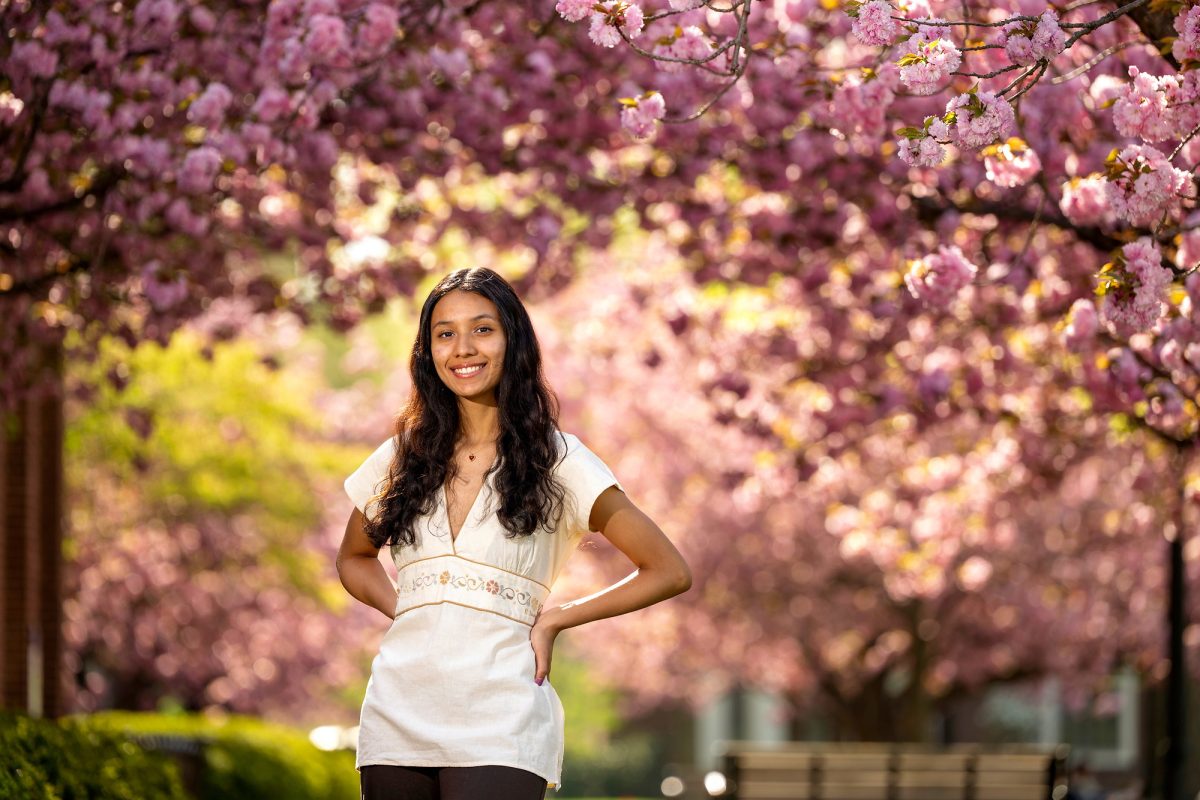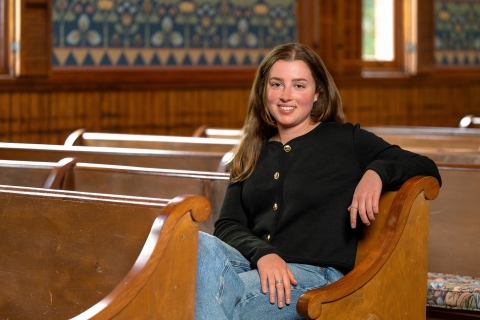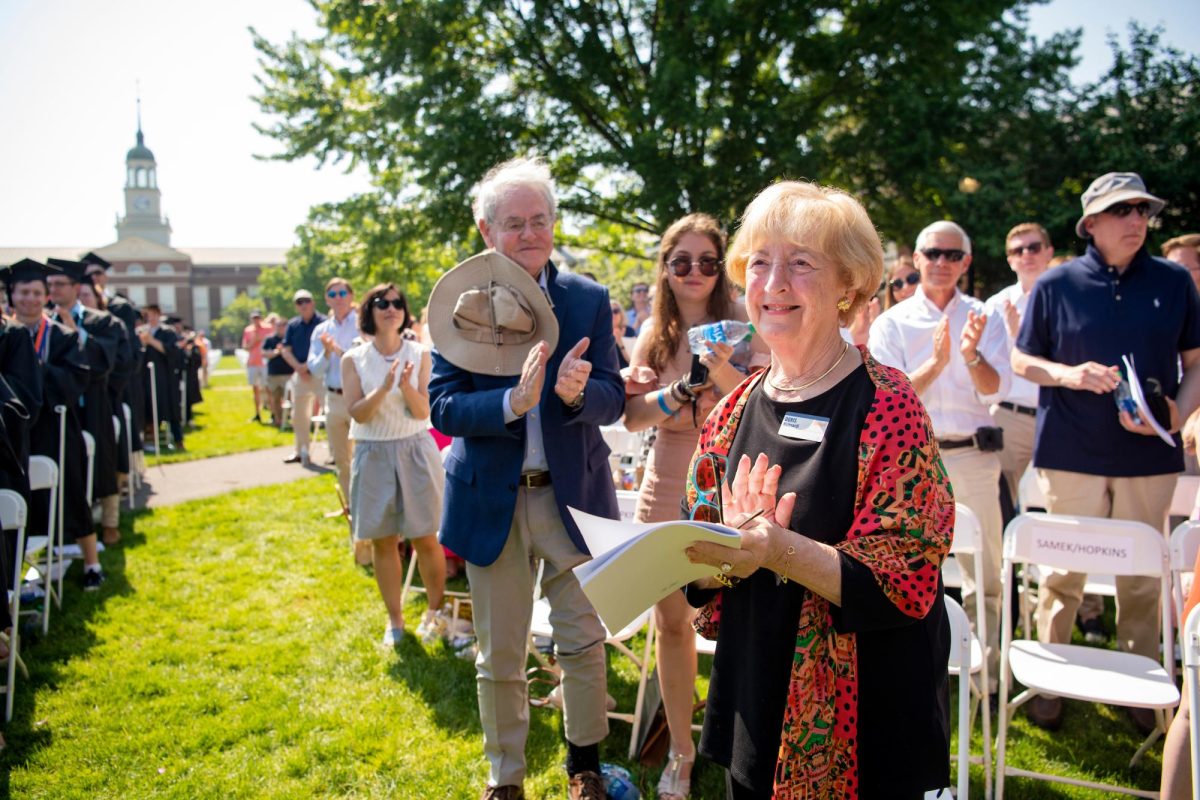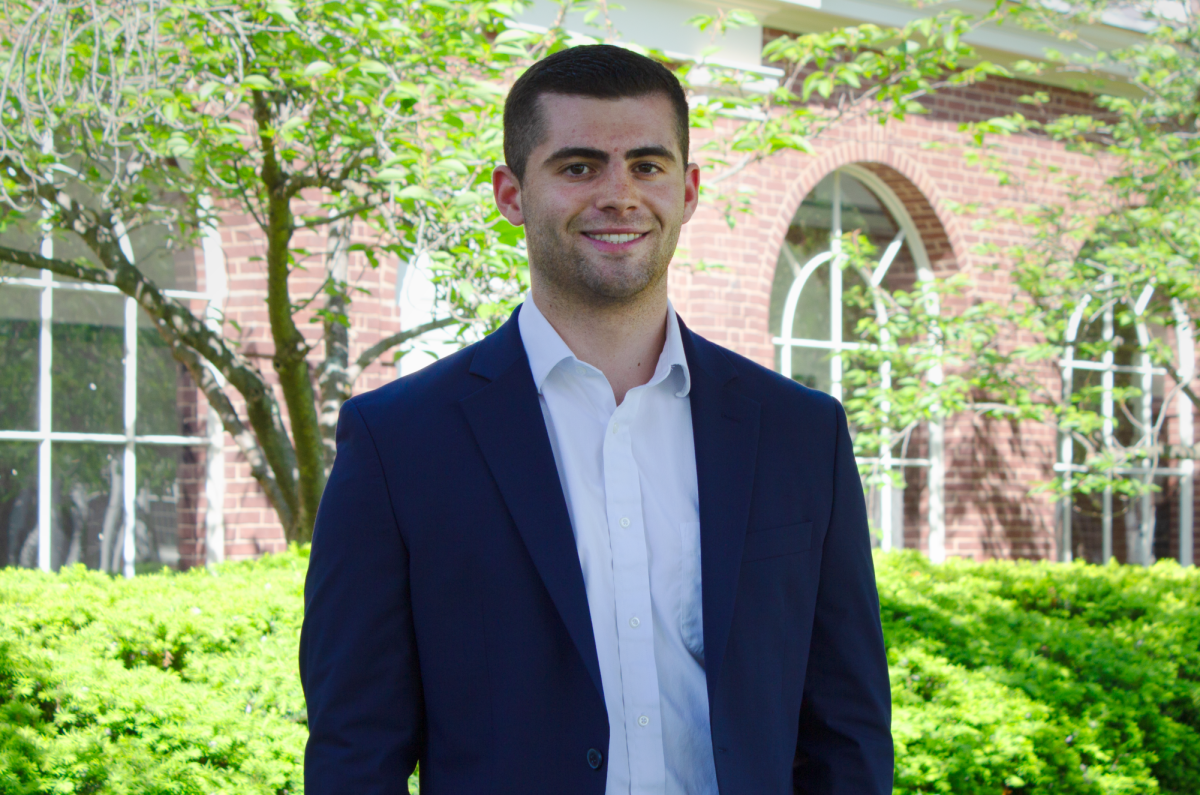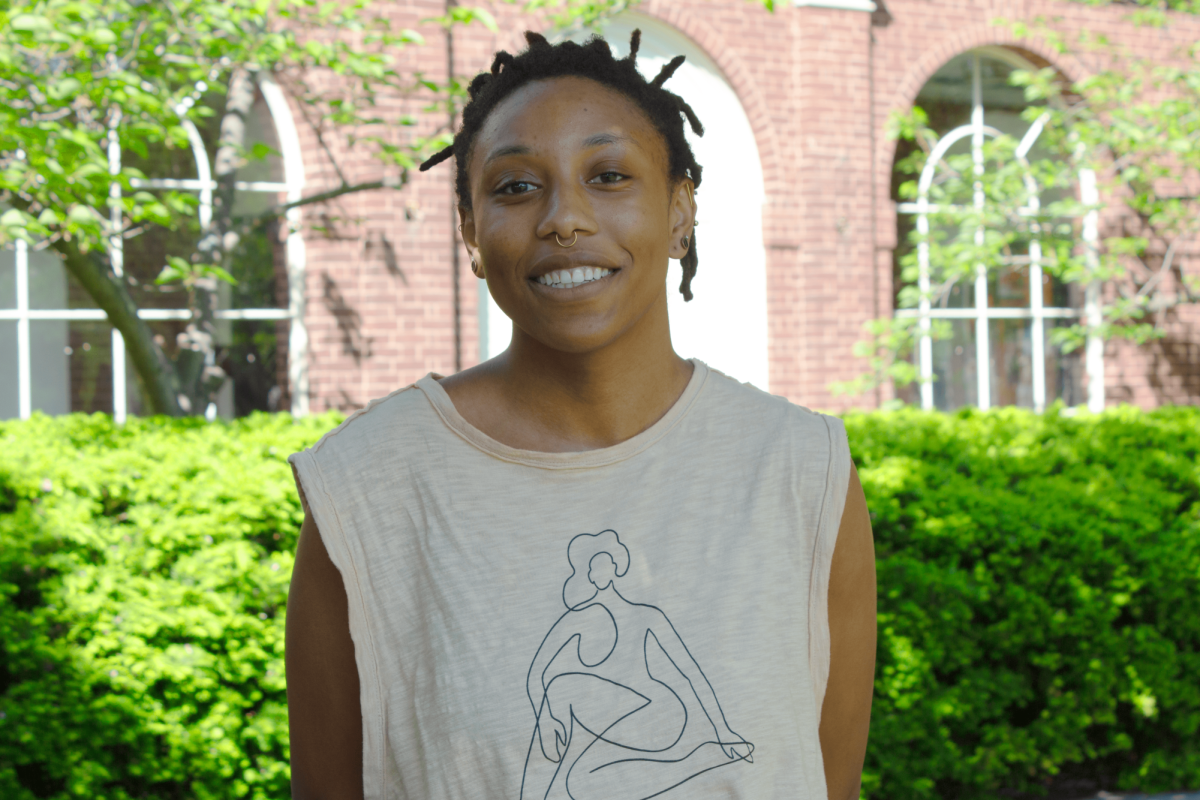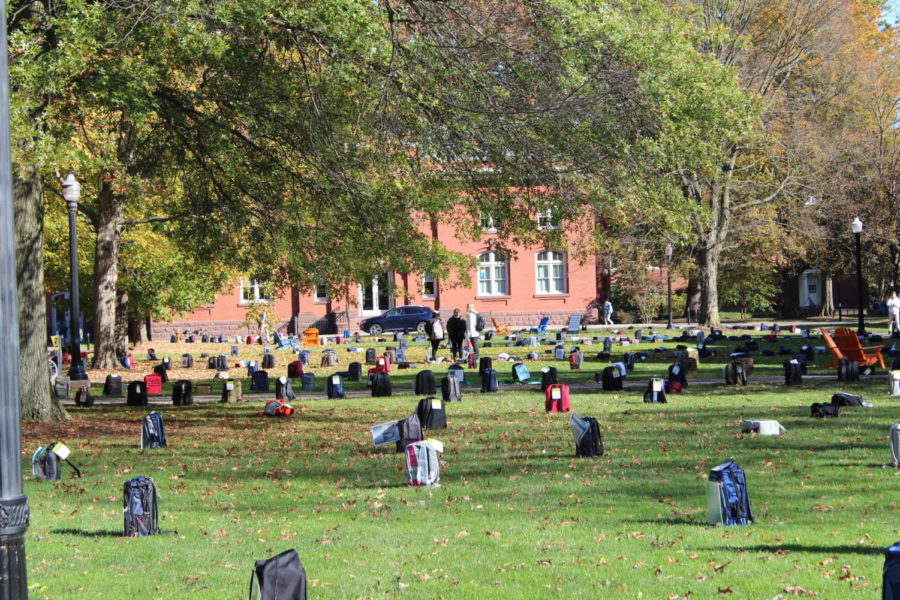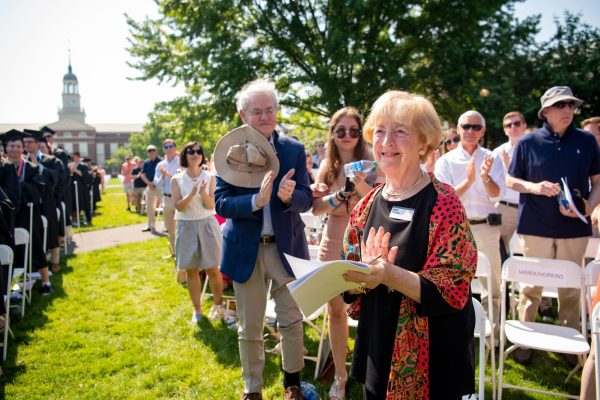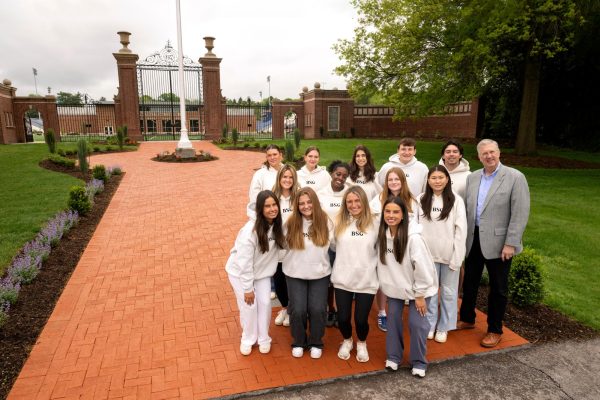Active Minds’ “Send Silence Packing” exhibit leaves a lasting impact on students
November 3, 2021
On Monday Nov. 1, the science quad was filled with 900 backpacks that served as a striking visual exhibit to promote action around suicide prevention and bring awareness to mental health issues; each backpack represented an individual who was either a victim or a survivor of suicide.
The Active Minds club brought this traveling exhibit, titled “Send Silence Packing,” to campus in an effort to reach students and showcase a moving perspective on the important issues of mental health and suicide that often permeate college campuses. According to the Active Minds website the “immersive experience,” is part of their larger national non-profit organization, which is present at over 600 schools around the nation; with 18 years of experience as a leader for young adult mental health advocacy and suicide prevention, they have impacted over eight million students by their presence.
The University’s chapter of Active Minds, which was reinstated two years ago by Joe Roffer ’22 and Hunter Thomas ’22, follows the same mission of “equip[ping] people with the resources and support to help effectively have conversations about, raise awareness for and de-stigmatize mental health issues.” “The goal of the exhibit was to promote suicide awareness and destigmatize the conversations about mental health,” co-presidents Roffer and Thomas said.
As cited from the Active Minds media kit, “the core of ‘Send Silence Packing’ is sharing stories.” At the center of the exhibit stood the “Beyond the Backpacks” display. Most of these backpacks were donated from families and friends of young, college aged, individuals who were either victims or survivors of suicide throughout the past few years. Attached to many of the backpacks are images and “stories about hope, recovery, and help-seeking experiences” from survivors or stories from “friends or family members who have survived the loss of a loved one” to suicide. The two national Active Minds representatives who were present at the event informed us that some of the backpacks did not have a personal individual and/or story attached to them, as they served to represent all of the individuals who might be silently going through mental health troubles each and every day.
The “Send Silence Packing” exhibit on the University’s campus featured one very important backpack and story: Peyton Rumachik’s. Rumachik was a 2018 University alumnus who tragically took his own life on June 3, 2018, shortly after graduating. Peyton’s parents have since created a movement inspired by his life and his belief in “paying it forward,” as a means of extending kindness and love to all individuals — the movement is titled “Peyton It Forward.” His backpack and bowtie were featured along with his story at the exhibit on Monday. There was also free coffee for anyone who came, which was donated by the Rumachik family who came to campus to support the event.
There was a tent set up at the center of the quad, in which the club’s leaders and the national representatives were available to talk to anyone who attended the exhibit while they handed out free stickers, pins, wristbands and informational pamphlets about the organization. At their table, the Active Minds club leaders “equipped students with mental health resources including a 45-minute suicide prevention training module for those to support others, information on both self-help and helping friends through mental health issues and fundraising for mental health awareness,” Roffer and Thomas said. Also under the tent was another element of the immersive experience: a virtual display on which viewers could listen to personal stories from survivors as well as families and friends of victims and/or survivors.
The University’s Counseling and Student Development Center (CSDC) as well as the Religious and Spiritual Life Center were also set up at tables on the quad to assist in sponsoring this exhibit. The former was there to serve as a resource and support system for those who experienced troubling feelings or negative reactions to the exhibit. The latter set up blank poster paper on their table where individuals could write responses to how they’re connecting with others and what they’re doing to feel centered. There were also members of Bucknell Student Government (BSG) and a kindness campaign by the Makerspace present at the event. In this way, the “Send Silence Packing” exhibit brought together many communities on campus to promote the goals and purposes of Active Minds.
In addition to Active Minds club leaders and members as well as the national Active Minds representatives, several students volunteered to help out at the exhibit. These volunteers were scheduled shifts throughout the day to stand around the quad and hand out pamphlets and engage in conversations with those who stopped by; they were also instructed to encourage individuals who displayed negative responses to the exhibit to talk with the counseling center. There were also signs posted around the outskirts of the science quad that provided trigger warnings for the exhibit; the warnings stated that the exhibit features stories about negative mental health and suicide, and encouraged individuals to think about their decision to participate in the exhibit.
“Being involved in Active Minds is important to me because I believe many college campuses lack effective conversation regarding mental health,” Active Minds social media chair Kelsee Dunn ’22 said. “Although impactful and powerful, I feel as though Send Silence Packing was an efficient way to invoke conversation surrounding suicide awareness.”
“Mental health is something that impacts every single college student and it is vital that we discover a way to effectively take care of it,” club member Megan Lutz ’22 said.
“I became involved with Active Minds after I became comfortable and experienced enough with my own depression in order to raise awareness and help people that deal with similar struggles to me. Helping out in the event this week was emotionally taxing but overall a good experience, and I got to meet a lot of nice people on campus that also held empathy for the same issues that the club does,” Ethan Sales ’22 said.
As previously mentioned, the exhibit took place on the science quad and lasted from 9 a.m. to 4 p.m. As a result, anyone who walked through the quad during the day was faced with the visually striking exhibit, which displayed the immense prevalence of the issue of suicide and addressed it explicitly. Despite the trigger warnings and the presence of many support systems at the event, there was some buzz on campus regarding whether this event did more harm than good. Specifically on YikYak, a social media platform that allows individuals to anonymously voice their opinions and thoughts, some were sharing that the exhibit negatively impacted them as they walked to class on a stressful Monday morning and that it was an unnecessarily explicit way to address this issue. Moreover, these reactions to the exhibit brought up the ongoing issue regarding the lack of availability and support from the Counseling and Student Development Center. While the counseling center is separate from the club, they are both linked by the issue of mental health at hand.
In response to these comments, Roffer and Thomas point to the presence of Active Minds members, CSDC, Religious and Spiritual Life and BSG, as their “purpose in having these entities present during the event included having open discussions about the campus environment on mental health and what could be improved.” “We wish we could have had the opportunity to speak to those students who were negatively impacted by the event,” Roffer and Thomas said.
Similarly, event volunteer Cian Nowak ’22 said, “I believe that while the exhibit was overpowering, that is what is needed to make a difference in suicide prevention. The topic has held stigma surrounding it for a long time, a powerful message needs to be made to show that it is okay to ask for help or talk about your struggles.”
The co-presidents concluded by saying: “We think this underlines the issues of the mental health climate on campus in that people are hesitant of having uncomfortable, but necessary conversations about mental health. The event was intended to spark conversations surrounding suicide and mental health, but it was disappointing to not receive those through more productive discussions either with our organization, BSG or the CSDC. We believe divisions in communication between us only further stigmatizes mental health rather than destigmatizing it. The more we collaborate as a community, the better we can foster a healthier mental environment on campus.”
The issue of mental health, especially when it comes to the most extreme negative outcomes, is a sensitive topic yet it is one that must be addressed. In an effort to do this difficult task, the Active Minds club often hosts “self-care events that both teach healthy self-care but also give students an outlet to practice it.” “We spread awareness through poster campaigns, mental health tabling, classroom/event presentations, and events such as ‘Send Silence Packing.’ With awareness, we believe in educating and equipping students with the tools and resources to help themselves and others,” Roffer and Thomas said. One specific tool the club employs to help facilitate their mission is their VARs training module, which is a method for listening and supporting individuals in crisis. They also give mental health presentations in classrooms in order to educate students about the resources available to them on campus, encourage self-care, and gauge opinions on the mental health climate on campus.
“Active Minds is attempting to fulfill this act of de-stigmatization through holding events that educate our communities on topics that we should not stay silent on,” Lutz said.
While there were mixed reactions to the “Send Silence Packing” exhibit, it succeeded in sparking discussion and leaving a lasting impact on those who were able to stop by. The presence of Active Minds on campus actively contributes to fostering a healthier environment where all individuals, students and faculty alike, can feel supported when facing mental health struggles.
